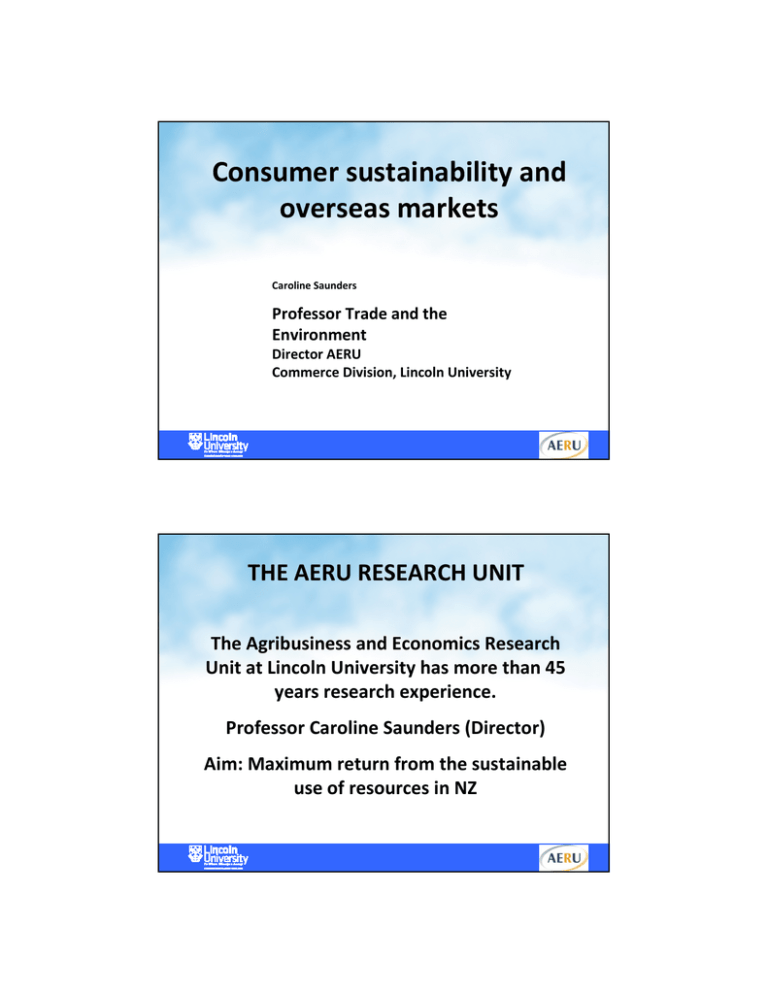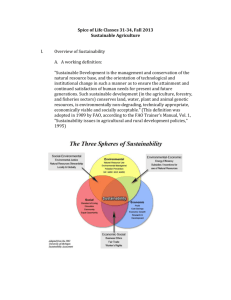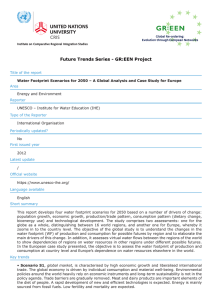Consumer sustainability and overseas markets THE AERU RESEARCH UNIT
advertisement

Consumer sustainability and overseas markets Caroline Saunders Professor Trade and the Environment Director AERU Commerce Division, Lincoln University THE AERU RESEARCH UNIT The Agribusiness and Economics Research Unit at Lincoln University has more than 45 years research experience. Professor Caroline Saunders (Director) Aim: Maximum return from the sustainable use of resources in NZ How Important is Trade to NZ? • Exports account for a third of our annual income • Compared to 8% in the US & 30% in the UK • Land-based products account for 70% of this trade • Most of this trade is with developed countries • Trade access important for NZ and value of exports NZ in the World NZ production is small compared to the world NZ built on exports to UK in meat and milk and diversified to supply other markets Concentrates upon high value exports NZ fall in ranking in OECD due to reliance on agricultural exports Main chance of staying a developed country is high value sustainable agricultural exports Market Access Trade/ agricultural policy Historically the main factor affecting exports - Countries subsidised production and exports and restricted imports - These are being reduced - Being replaced by payments and policies for environmental, social and local food Market Trends - Consumer Preferences • Small proportion of income on food (under 10%, of which lucky if 5% goes to farmer) • In UK 40% of meals taken outside home • Consumers changed. So attributes of food more important than price in high value markets we want to target • Key attributes include food safety and quality followed by sustainability, convenience and health NZ Brand • NZ does brand itself as Clean and Green • 100% pure – used by tourism • Other brands also important such as Zespri and Anchor • Generally surveys overseas show positive reaction to NZ brand • Need to maintain this to access high value premium markets Risks and Opportunities for our Exports • To access premium market segments have to consider sustainability including social & environmental factors • Often these are defined by overseas markets • We have to ensure these factors are defensible and not pseudo • Food miles ignores production resource use Dairy and Lamb – UK versus NZ • NZ uses under half energy than the UK does • Even when methane and nitrous oxide included the UK produces 34% more GHG emissions per kgMS and 30% more per ha • NZ is 4 times more energy efficient that the UK in lamb production NZ and UK Production • Food miles report assumes UK could replace supply at same intensity • NZ supplies 18% of sheepmeat; 13% butter and 58% apples; of UK supply • To replace this would require increase in UK production intensity and consequential environmental damage which the CAP reforms are ameliorating Carbon Footprinting Methodology • • • • • • • Food miles recognised as flawed concept Retailers and others now carbon footprinting Keen to develop standard methodology DEFRA, Carbon Trust and BSI have done this PAS Publically available standard Offsetting not allowed and reduction is key WRI also developing standard with ISO Carbon Footprinting • 15 schemes implemented world wide • UK Carbon Trust in 2006 did 3 products • Tesco in 2007 said they would do all 70,000 products (done 6 product lines) Now moving scheme into South Korea • Tesco committed to reduce carbon by 30% • Japan, Germany, Thailand, Sweden and Switzerland also have schemes. Issues with Carbon Labelling • Cost of carbon footprinting especially for developing countries and small suppliers • Concern re: methodology and science • Concern that a monopoly certifier will emerge • Potential for acting as a trade barrier • Unidimensionality of carbon footprint against other sustainability criteria • Lack of understanding of the footprint Sustainability & Market Access Issues • • • • • • • Local food and seasonal consumption Lower meat and dairy consumption Ethical food - fair trade and organic! Biodiversity and wildlife Water quality and quantity Ageing Population Food waste Local Food and Seasonal Consumption • Growing demand for local food • UK and US government promoting local food and food miles! (sausages from supermarket would have to travel 227,727 miles to have same footprint as those from local shop) • Growth in local farmers markets, box schemes ect • Seasonal consumption also may not be better for the environment • Also consider wider sustainability implications • Choice editing • Waitrose will be the first supermarket to stock their own 100% British dairy products, and customers will be able to trace its provenance from farm to fridge • This is great news for the cows and the British farmers and the environment. The cows are being raised in the lap of luxury. They are living in light airy barns, with clean beds of straw or a specially designed comfy matress; nutritional advisors to ensure a healthy diet and pedicures- their hooves are regularly trimmed. Who’s Doing What • Tesco’s – Setting up 8 local source buying offices • M & S –double regional food sourcing by 2012 • Sainsbury’s source all food from sustainable sources • ASDA – promote local produce, cut food miles and extend British growing season - increase British farmers from 2500 to 3500 and increase local food hubs Lower Meat and Dairy Consumption Low Carbon Diets • Demand for reduction in meat and dairy consumption (livestock 18% of worlds total) • ‘meat free Monday’ Paul McCartney • Ghent – meat free one day a week • WWF meat should be labelled 1-3 tiems a week max • NHS – reducing meat and dairy in diets Meat and Dairy Diets • Research shows that dairy based diet not much different from vegan diet for emissions (6%) • Meat based diet more emissions (23% more) • Further research into alterative sources of supply for meat and its by products Animal Welfare • Mintel says with 40% Britain's biggest food concern • Ban on Battery chicken in EU by 2012 • The Freedom Food - RSPCA 1994. Sainsbury’s have increase of 90% sales 2009/10 in chicken ($190m) • M & S no meat and milk from stock who are zero grazed all year • UK only allows ring castration of lambs without anaesthetic when under week old Ethical food and fair trade • Growing market – LOHAS (19% US market) and Slow Food Movement (132 countries) • Ensure social sustainability and thus account for social conditions of workers • Against ‘unnatural ‘ farming and promotion of organic and local food • Organic food down in UK but ethical food growing Biodiversity and Wildlife • Many overseas market access schemes are asking for wildlife and biodiversity plan • Overseas large subsidies for this include restrictions on stocking and haymaking in bird friendly manner • In NZ some sectors have these such as Kiwi fruit • Others not really considered this • Need care that because we have large conservation estate that we don’t ignore agricultural land Water Quality and Quantity • Water quality is growing issue • In UK alone proposed 70% of land under NVZ • In NZ vulnerable especially in Canterbury with growing conversion to dairy and nitrate pollution • Increase use of fertiliser in NZ (nitrogen fertilizer use has increased 4-fold 1990-1995) • Water Quantity is also a growing concern and part of many retailers targets. In NZ we use probably more water as less of a shortage but still an issue Increases in Groundwater Nitrates 1989-2007 • MfE, Our rivers: trends in water quality, 2009 Water Footprint Calculator • http://www.waterfootprint.org/?page=cal/waterfootprintcalculator_indv Emerging Markets • Considerable growth especially for livestock products (but much met by their own increase in production) • One billion middle class in Asia, Latin America and central and eastern Europe • Main change from small retailers to supermarkets and global procurement • Eg China from no supermarkets in 1990 to 60,000 • Growth from western chains (Tesco Walmart) and these likely to require same standards of procurement for their other markets Ageing Population - Seniors • Account for fifth of food and beverage consumers and growing ($741 US in 2006) • Interested in health and functional foods • Willing to change diets • Functional foods estimated to grow by 56% 2008 to 2011 Food Waste • UK 30 % of food wasted (60% edible) • US 40 – 50% wasted Other Countries being subsidies to met sustainability requirements • EU Single Farm Payment – subsidises farmers to comply with environmental criteria and will include carbon footprinting (75bill euros) • EU also pays extra for farmers for agri-environmental schemes to – (22 bill euros) • EU pays to help comply with market schemes (92 million ecu) • US – increase in conservation area (115 million acres) • Increase in payments for working land conservation (US$3.4 billion) NZ Brand • NZ levered off low population and natural sceneryBrand vulnerable however • Other countries are catching up on market access including Chile, China and Uruguay has meat accepted by Global gap • GlobalGap – incorporating gradually other countries schemes such as Thai Gap • 80,000 producers in 80 countries • Need to increase our sustainability credentials to maintain market access and premium prices Conclusion • Threats to trade changing from regulatory to ‘access-to-market from retailers’ • This has been developing over time • Carbon footprints are an example of this • Not just EU markets it is spreading elsewhere • However win-win more returns for exports and more sustainable production



